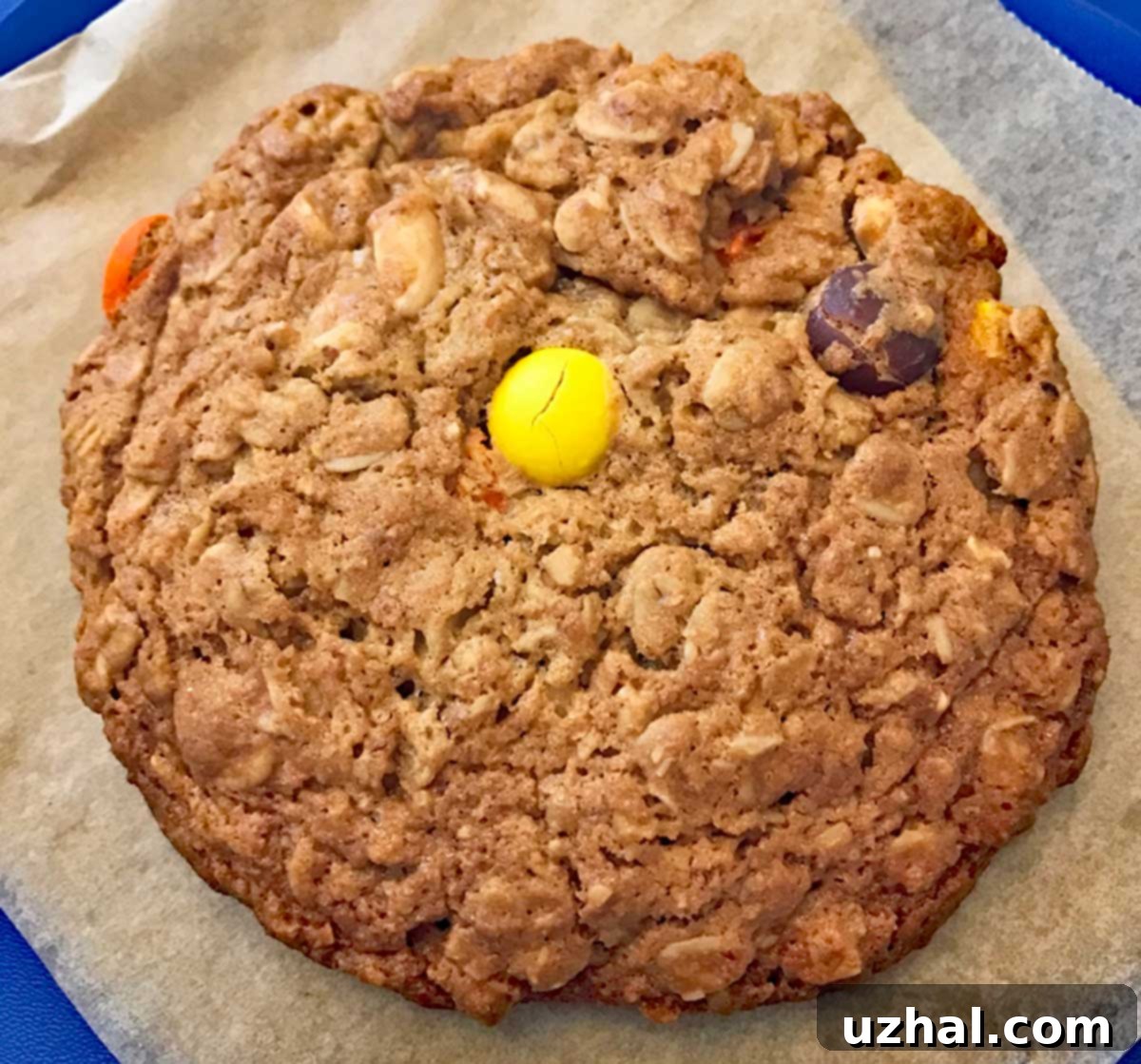Toasted Wheat Germ Monster Cookies: A Nutritious and Flavorful Twist on a Classic Treat
Monster Cookies have always held a special place in the hearts of cookie lovers, celebrated for their hearty blend of peanut butter, oats, and M&M’s. I often like to affectionately think of them as the “healthiest of unhealthy foods” – a delightful indulgence that surprisingly offers more nutritional benefits than your average sweet treat. While they certainly contain sugar, these beloved cookies also pack a punch of goodness from ingredients like protein-rich peanut butter, fiber-filled oats, and essential nutrients from eggs. This foundational mix provides a solid base for a satisfying snack. But what if we could elevate that “relative healthiness” even further? That’s precisely where these Toasted Wheat Germ Monster Cookies come into play, affirming my belief that a little extra effort can make a big difference.
The addition of wheat germ, a nutritional powerhouse, transforms these already substantial cookies. Wheat germ is renowned for being an excellent source of Vitamin E, a potent antioxidant, but its benefits extend far beyond that. It’s also rich in B vitamins, folic acid, phosphorus, magnesium, and zinc, making it a valuable supplement to any diet. Incorporating toasted wheat germ into Monster Cookies not only enhances their nutritional profile but also introduces an exciting new dimension of flavor and texture. While we’re not claiming these are bona fide health foods, they are undoubtedly a step up, offering a guilt-less pleasure with every chewy, delicious bite. Prepare to experience a familiar favorite reimagined with a delightful, wholesome twist.
Why Add Wheat Germ to Your Monster Cookies?
It’s easy to get carried away and playfully exaggerate the nutritional merits of Monster Cookies. However, there’s no jesting when it comes to the genuine value that toasted wheat germ brings to these beloved treats. Far from being a mere filler, wheat germ is a strategic addition that significantly enhances the cookies in several key ways, making them even more irresistible and subtly better for you. Let’s delve into why this ingredient is such a fantastic choice for your next baking adventure.
First and foremost, toasted wheat germ introduces a distinctive, inviting flavor profile. When lightly toasted, it develops a wonderfully nutty, slightly earthy taste that perfectly complements the rich sweetness of peanut butter and the wholesome character of oats. This toasty essence adds a layer of depth and complexity that elevates the overall cookie experience, moving beyond just sweet and chewy to something more sophisticated and satisfying. It’s a subtle but impactful note that will have everyone wondering about your secret ingredient.
Beyond flavor, wheat germ also works wonders for texture. It contributes a pleasant, delicate crispness that contrasts beautifully with the usual soft and chewy interior of a Monster Cookie. This added texture provides a more dynamic eating experience, preventing the cookies from being uniformly soft and adding a delightful crunch that makes each bite more engaging. The finely ground nature of wheat germ integrates seamlessly into the dough, distributing its unique texture throughout the cookie without being overpowering.
From a nutritional standpoint, the benefits are undeniable. As mentioned, wheat germ is a concentrated source of vital nutrients. It’s packed with dietary fiber, which aids in digestion and helps maintain a feeling of fullness. It provides significant amounts of B vitamins, crucial for energy metabolism, and essential minerals like phosphorus, magnesium, and zinc, which play roles in bone health, muscle function, and immune support. So, while you’re enjoying a decadent cookie, you’re also getting a discreet boost of micronutrients – a win-win situation for any treat!
One important consideration, however, is that traditional Monster Cookies are often seen as a convenient gluten-free alternative for those with sensitivities, thanks to their oat-based nature. The unfortunate drawback of adding wheat germ is that it contains gluten, as it is a component of the wheat kernel. If gluten is a concern for you or your guests, this ingredient will compromise the gluten-free status of the cookies. But don’t despair! You can still achieve a similar textural enhancement. Simply substitute the wheat germ with an equal amount of quick oats or, for a finer texture, grind about ⅓ cup of regular old-fashioned oats into a coarse flour. While these alternatives won’t replicate the unique toasted flavor of wheat germ, they will certainly improve the texture, adding a delightful chewiness. If you’re really chasing that toasted note but need to avoid gluten, you could try lightly toasting your substitute oats in the oven before adding them to the batter. This process deepens their flavor, offering a different, but still enjoyable, dimension to your Monster Cookies.
Unlock New Flavors: More Toasted Wheat Germ Recipes and Uses
Once you discover the delightful impact of toasted wheat germ in your Monster Cookies, you’ll likely find yourself eager to explore its versatility in other baked goods and dishes. This unassuming ingredient is a secret weapon for adding flavor, texture, and a nutritional boost to a wide array of recipes. Here are some fantastic ways to incorporate toasted wheat germ into your culinary repertoire, extending its magic beyond just these incredible cookies.
Cookies and Sweet Treats
If you’ve fallen in love with the nutty, toasty essence of wheat germ in cookies, you must try Maida Heatter’s Jumbo Chocolate Chip Cookies. In this classic recipe, the wheat germ adds an unexpected depth of flavor that beautifully complements the sweetness of the chocolate chips, creating a more complex and satisfying cookie. It also contributes a subtle chewiness and a hint of a rustic texture that sets these chocolate chip cookies apart from the rest. Imagine the perfect balance of rich chocolate, tender cookie, and that delightful, earthy undertone – simply divine.
Breads and Muffins
Wheat germ is also a fantastic addition to various breads. For instance, a traditional German Rye Bread often calls for a little wheat germ, where it enriches the robust, tangy flavor of rye flour and improves the bread’s crumb. It can make the texture slightly softer and add a desirable chew. Similarly, in the world of muffins, wheat germ excels. Our Favorite Bran Muffins recipe, for example, calls for a generous full cup of wheat germ! This substantial addition boosts the fiber content dramatically, makes the muffins incredibly moist and tender, and imparts a wonderful, wholesome flavor that perfectly complements the bran. You’ll find the muffins are more substantial and satisfying, making them an ideal breakfast or snack option.
Another excellent example is the Chicago Food Swap Banana Chocolate Muffins, which are arguably my favorite banana muffin recipe. Here, the wheat germ improves the texture, adding a pleasant, slightly chewy density that works harmoniously with the soft banana and melty chocolate. It provides a subtle counterpoint to the sweetness, creating a more balanced and intriguing flavor profile. It’s the kind of enhancement that takes a good muffin and makes it truly great.
Beyond Baking: Everyday Uses
The utility of toasted wheat germ isn’t limited to just baking. It’s incredibly versatile for everyday culinary applications. Consider sprinkling a tablespoon or two over your morning yogurt, oatmeal, or smoothie for an instant nutritional upgrade. Its nutty flavor makes it a wonderful addition to homemade granola or as a topping for fruit salads. You can also use it in savory contexts: mix it into breading for chicken or fish for an extra crispy and flavorful crust, or sprinkle it over a green salad for a delightful textural crunch. Some even mix it into meatloaf or meatballs to add moisture and nutrients. Stored properly in the refrigerator or freezer, toasted wheat germ will remain fresh and ready to enhance countless dishes, making it a staple ingredient once you discover its full potential.
Explore More Related Recipes!
If you’re eager to continue your baking journey with new and exciting recipes, especially those featuring unique ingredients and fantastic flavors, you’ve come to the right place. Dive into these delightful creations that promise to satisfy your cravings and expand your baking repertoire:
- Butterscotch, Pecan & Toasted Wheat Germ Cookies
- Chewy Coconut Chocolate Chip Granola Bars
- King Arthur Monsters with Flour
- Chocolate Chip or Butterscotch Chip, Nut and Wheat Germ Cookie Bark
Recipe

Toasted Wheat Germ Monsters
Anna
Pin Recipe
Ingredients
- 1 ¼ cups old fashioned oats, (120 grams)
- ¼ cup toasted wheat germ (see note on how to toast) (20 grams)
- 1 large egg
- ⅓ cup sugar (67 grams)
- ⅓ cup brown sugar (68 grams)
- ⅓ cup peanut butter plus 1 tablespoon (110 grams)
- 3 tablespoons butter, very soft (almost melted) and cooled (42 grams)
- ¾ teaspoon vanilla extract
- ¾ teaspoon baking soda, scant
- ¼ teaspoon salt, scant
- ½ cup assorted candies (Reese’s Pieces)
- ½ cup peanut butter chips
Instructions
-
Preheat oven to 350 degrees F.
-
In a large mixing bowl, using an electric mixer, beat the egg and both sugars for about a minute or until the mixture becomes lighter in color and slightly fluffy. Then, beat in the peanut butter, vanilla extract, and salt until well combined. Finally, add the baking soda and beat for about 30 seconds to fully incorporate it.
-
Gently add the old-fashioned oats and toasted wheat germ mixture to the wet ingredients. Stir until everything is just blended, making sure not to overmix. Once the dry ingredients are incorporated, fold in your choice of assorted candies (like Reese’s Pieces) and peanut butter chips.
-
At this stage, you have a few options for preparing the dough. You can cover the mixing bowl and let the dough stand at room temperature for about 10 minutes; this allows the oats to absorb moisture, resulting in a more uniform texture. Alternatively, you can drop the batter into 8 generous mounds onto a dinner plate or two, then cover and chill the mounds for at least 30 minutes. If you’re feeling eager and don’t mind a slightly stickier process, you can roll up your sleeves and immediately attempt to mash the mixture into firm balls.
-
Once the mixture is a little firmer (either from resting or chilling, which helps the oats absorb moisture), mold it into firm, uniform balls. Then, gently press down on each ball to flatten it to about 1 inch in thickness. This step is crucial for ensuring that your Monster Cookies bake evenly and achieve that perfect chewy-crisp balance.
-
When you’re ready to bake, arrange the flattened cookie dough rounds on a parchment-lined baking sheet. Make sure to space them generously, about 3 inches apart, as these Monster Cookies will spread considerably during baking.
-
Bake at 350 degrees F for approximately 13-15 minutes, or until the edges of the cookies are nicely browned and the centers are just set. Keep in mind that if your dough rounds were chilled, they might require a minute or two longer to bake through. For an alternative baking method, you can preheat your oven to 325 degrees F and bake for 14 to 18 minutes. Once baked, remove from the oven and let them cool completely on the baking sheet before transferring to a wire rack. This allows them to firm up properly and prevents them from breaking.
Notes
For variations, feel free to experiment with different mix-ins! Instead of or in addition to Reese’s Pieces and peanut butter chips, consider adding chocolate chips, white chocolate chips, chopped nuts (pecans, walnuts), or even a sprinkle of sea salt on top before baking for a sweet and salty twist. Store leftover cookies in an airtight container at room temperature for up to 3-4 days, or freeze for longer enjoyment.
